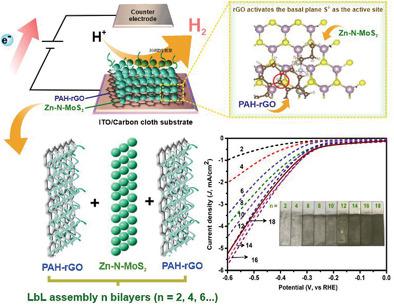当前位置:
X-MOL 学术
›
Adv. Mater. Interfaces
›
论文详情
Our official English website, www.x-mol.net, welcomes your feedback! (Note: you will need to create a separate account there.)
A Scalable Interfacial Engineering Strategy for a Finely Tunable, Homogeneous MoS2/rGO‐Based HER Catalytic Structure
Advanced Materials Interfaces ( IF 5.4 ) Pub Date : 2020-04-02 , DOI: 10.1002/admi.201902022 Linan Xu 1, 2 , Yihe Zhang 1 , Lili Feng 2 , Xin Li 2 , Qi An 1
Advanced Materials Interfaces ( IF 5.4 ) Pub Date : 2020-04-02 , DOI: 10.1002/admi.201902022 Linan Xu 1, 2 , Yihe Zhang 1 , Lili Feng 2 , Xin Li 2 , Qi An 1
Affiliation

|
The electronic structures and catalytic efficacies of molybdenum disulfide (MoS2)‐based catalysts are sensitive to embedding environment. In order to develop a finely tunable strategy, a “layer‐by‐layer and Nafion capping” strategy for the scalable preparation of interfacial (MoS2)‐based catalytic structures is developed. The study shows that the assembly partner influences the electronic structures of the Zn&N co‐doped (MoS2) (Zn‐N‐(MoS2)) catalysts. Poly(allylamine hydrochloride) (PAH) decreases the catalytic efficacy, whereas when PAH‐rGO (rGO [reduced graphene oxide]) is the assembly partner, effective interfacial catalysts are prepared. The superior catalytic efficacy of (PAH‐rGO/Zn‐N‐(MoS2))n can be attributed to the fact that rGO effectively activates the basal plane S2− as the active sites. The catalytic efficacy of the multilayers at 16 assembly cycles due to a balance between the number of active sites and low resistance. After capping with Nafion layer, the interfacial catalysts exhibit high stability. Compared with the widely used drop‐casting methods, the layer‐by‐layer strategy possesses unique benefits, including fine‐tune the structures, free choice of the partner, and planar homogeneity. It is expected that this layer‐by‐layer catalyst immobilization strategy will benefit fundamental understandings regarding the finely controlled scalable interfacial immobilization of catalysts with superior efficacy, and assist in promoting the practical utilization of various catalysts.
中文翻译:

基于MoS2 / rGO的精细可调均质HER催化结构的可扩展界面工程策略
基于二硫化钼(MoS 2)的催化剂的电子结构和催化效率对嵌入环境敏感。为了开发一种可微调的策略,开发了一种可扩展的基于界面(MoS 2)的催化结构制备的“逐层和Nafion封端”策略。研究表明组装伙伴会影响Zn&N共掺杂(MoS 2)(Zn-N-(MoS 2))催化剂的电子结构。聚烯丙胺盐酸盐(PAH)会降低催化效率,而当PAH-rGO(rGO [还原石墨烯氧化物])为组装伙伴时,则可以制备有效的界面催化剂。(PAH-rGO / Zn-N-(MoS 2))的出色催化功效n可以归因于rGO有效激活了基底平面S 2-作为活动位点的事实。由于活性位点数目和低电阻之间的平衡,多层在16个组装循环时的催化功效。用Nafion层覆盖后,界面催化剂显示出高稳定性。与广泛使用的压铸法相比,逐层策略具有独特的优势,包括微调结构,伙伴的自由选择和平面均匀性。可以预期,这种逐层催化剂固定化策略将有益于对具有优异功效的催化剂的精细控制的可扩展界面固定化的基本理解,并有助于促进各种催化剂的实际利用。
更新日期:2020-04-02
中文翻译:

基于MoS2 / rGO的精细可调均质HER催化结构的可扩展界面工程策略
基于二硫化钼(MoS 2)的催化剂的电子结构和催化效率对嵌入环境敏感。为了开发一种可微调的策略,开发了一种可扩展的基于界面(MoS 2)的催化结构制备的“逐层和Nafion封端”策略。研究表明组装伙伴会影响Zn&N共掺杂(MoS 2)(Zn-N-(MoS 2))催化剂的电子结构。聚烯丙胺盐酸盐(PAH)会降低催化效率,而当PAH-rGO(rGO [还原石墨烯氧化物])为组装伙伴时,则可以制备有效的界面催化剂。(PAH-rGO / Zn-N-(MoS 2))的出色催化功效n可以归因于rGO有效激活了基底平面S 2-作为活动位点的事实。由于活性位点数目和低电阻之间的平衡,多层在16个组装循环时的催化功效。用Nafion层覆盖后,界面催化剂显示出高稳定性。与广泛使用的压铸法相比,逐层策略具有独特的优势,包括微调结构,伙伴的自由选择和平面均匀性。可以预期,这种逐层催化剂固定化策略将有益于对具有优异功效的催化剂的精细控制的可扩展界面固定化的基本理解,并有助于促进各种催化剂的实际利用。



























 京公网安备 11010802027423号
京公网安备 11010802027423号